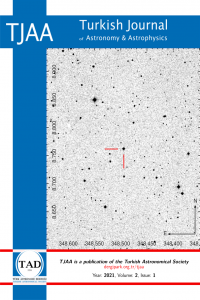Öz
Kaynakça
- Agol E., Steffen J., Sari R., Clarkson W., 2005, MNRAS, 359, 567
- Aladag Y., 2021, Master’s thesis, ÇÜ FBE Astronomi ve Astrofizik, Çukurova University
- Bastürk Ö., Hinse T. C., Özavcı I., Yörükoˇglu O., Selam S. O., 2015, in Rucinski S. M., Torres G., Zejda M., eds, Astronomical Society of the Pacific Conference Series Vol. 496, Living Together: Planets, Host Stars and Binaries. p. 370 (arXiv:1508.04500)
- Bevington P. R., Robinson D. K., 1992, Data reduction and error analysis for the physical sciences, p.44. McGraw-Hill Education
- Ciceri S., et al., 2013a, VizieR Online Data Catalog, pp J/A+A/557/A30
- Colón K. D., Ford E. B., Lee B., Mahadevan S., Blake C. H., 2010, MNRAS, 408, 1494
- Foreman-Mackey D., Hogg D. W., Lang D., Goodman J., 2013, PASP, 125, 306
- Fulton B. J., Shporer A., Winn J. N., Holman M. J., Pál A., Gazak J. Z., 2011, The Astronomical Journal, 142, 84
- Husnoo N., Pont F., Mazeh T., Fabrycky D., Hébrard G., Bouchy F., Shporer A., 2012, MNRAS, 422, 3151
- Kundurthy P., Becker A. C., Agol E., Barnes R., Williams B., 2013, The Astrophysical Journal, 764, 8
Öz
In this study, the transit observations of HAT-P-16b and TrES-3b exoplanets were carried out at ÇÜ UZAYMER Observatory with a 50 cm Ritchey Chretien type telescope. By analyzing the light curves of both exoplanets, system parameters have been obtained with acceptable models. Some of these parameters for HAT-P-16 systems were found to be: MP =4.172±0.163 MJ , RP =1.309±0.111 RJ , a/R=7.1922±0.0017 and b=0.1003±0.1533 which are consistent with the values given in Buchhave et al. (2010). Also, for the TrES-3 system, the same parameters were calculated as MP =1.959±0.111 MJ , RP =1.320±0.169 RJ , a/R=6.0656± 0.4899 and b=0.7892±0.0700. These values are also consistent with the values given in O’Donovan et al. (2007). No significant Transit Timing Variations (TTV) was found as a result of the Lomb-Scargle (LS) periodogram for HAT-P-16b by using the transit times obtained from the transit light curves (False Alarm Probabilities – FAP) = %96) . However, a significant periodicity was found at 32.38 days and a secondary periodicity was found at 41.07 days were determined as a result of the LS periodogram obtained from the TrES-3b data. We interpret that these periods with FAP of 3.41 % and 1.88 %, respectively, are close to the rotation period of the host star. Therefore, these periods could be due to the modulation of spot-induced light variations.
Anahtar Kelimeler
planets and satellites: individual: HAT-P-16b and TrES-3b planetary systems methods: observational techniques: photometric methods: data analysis
Kaynakça
- Agol E., Steffen J., Sari R., Clarkson W., 2005, MNRAS, 359, 567
- Aladag Y., 2021, Master’s thesis, ÇÜ FBE Astronomi ve Astrofizik, Çukurova University
- Bastürk Ö., Hinse T. C., Özavcı I., Yörükoˇglu O., Selam S. O., 2015, in Rucinski S. M., Torres G., Zejda M., eds, Astronomical Society of the Pacific Conference Series Vol. 496, Living Together: Planets, Host Stars and Binaries. p. 370 (arXiv:1508.04500)
- Bevington P. R., Robinson D. K., 1992, Data reduction and error analysis for the physical sciences, p.44. McGraw-Hill Education
- Ciceri S., et al., 2013a, VizieR Online Data Catalog, pp J/A+A/557/A30
- Colón K. D., Ford E. B., Lee B., Mahadevan S., Blake C. H., 2010, MNRAS, 408, 1494
- Foreman-Mackey D., Hogg D. W., Lang D., Goodman J., 2013, PASP, 125, 306
- Fulton B. J., Shporer A., Winn J. N., Holman M. J., Pál A., Gazak J. Z., 2011, The Astronomical Journal, 142, 84
- Husnoo N., Pont F., Mazeh T., Fabrycky D., Hébrard G., Bouchy F., Shporer A., 2012, MNRAS, 422, 3151
- Kundurthy P., Becker A. C., Agol E., Barnes R., Williams B., 2013, The Astrophysical Journal, 764, 8
Ayrıntılar
| Birincil Dil | İngilizce |
|---|---|
| Konular | Astronomik Bilimler (Diğer) |
| Bölüm | Makaleler |
| Yazarlar | |
| Yayımlanma Tarihi | 30 Haziran 2021 |
| Gönderilme Tarihi | 10 Mayıs 2021 |
| Kabul Tarihi | 16 Haziran 2021 |
| Yayımlandığı Sayı | Yıl 2021 Cilt: 2 Sayı: 1 |
TJAA, Türk Astronomi Derneğinin (TAD) bir yayınıdır.


